Qiu X.G. (Ed.) High Temperature Superconductors
Подождите немного. Документ загружается.

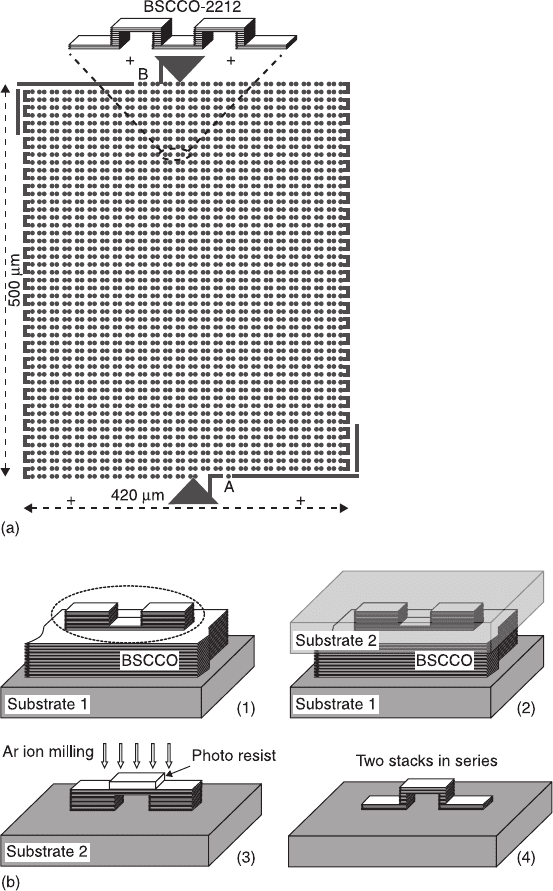
352 High-temperature superconductors
1
2
3
4
5
6
7
8
9
10
1
2
3
4
5
6
7
8
9
20
1
2
3
4
5
6
7
8
9
30
1
2
3
4
5
6
7
8
9
40
1
2
43X
© Woodhead Publishing Limited, 2011
8.29 3-D array of 2500 intrinsic Josephson junction stacks prepared by
FIB etching: (a) optical photograph and schematic detail, (b) double sided
fabrication process (Wang et al., 2003, Figs 1 and 2, Copyright (2003)
by IOP Publishing Ltd). For details of the fabrication process see Wang
et al. (2003). Reprinted with permission from Wang HB, Chen J, Wu
PH, Yamashita T, Vasyukov D, and Müller P (2003), ‘Intrinsic Josephson
junctions: integrated circuits and possible applications’, Supercond. Sci.
Technol. 16, 1375–1379, Fig. 1, Copyright (2003) by IOP Publishing Ltd.
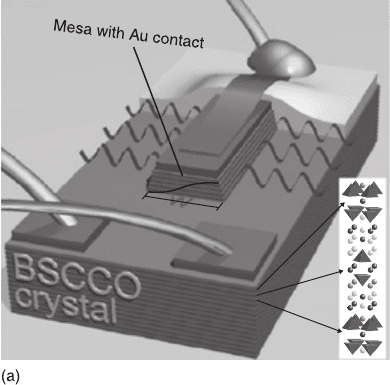
High-T
c
Josephson junctions 353
1
2
3
4
5
6
7
8
9
10
1
2
3
4
5
6
7
8
9
20
1
2
3
4
5
6
7
8
9
30
1
2
3
4
5
6
7
8
9
40
1
2
43X
© Woodhead Publishing Limited, 2011
New concepts like tuning of the emitted frequency by additional d.c. currents
have been proposed by Tachiki et al. (2005). Their simulations give emitted
powers up to more than 1 mW for a 100 µm × 500 µm stack. A very promising
work by Ozyuzer et al. (2007) offers a way out by using the flux motion without
external magnetic field in these arrays with lateral dimensions in the 100 µm
range, Fig. 8.30. A high power radiation of 0.5
µ
W at frequencies up to 0.85 THz
has been observed. In analogy to a laser cavity, the excitation of a geometrical
electromagnetic cavity resonance inside the sample generates a macroscopic
coherent state in which a large number of junctions oscillate in phase. Even if the
mechanism is up to now not clear, see for example Tachiki et al. (2009), Grib and
Seidel (2009) and references therein, such compact solid-state sources of coherent
THz radiation are being sought for sensing, imaging and spectroscopy applications
across the physical and biological sciences. Kadowaki et al. (2008) improved the
power of emission significantly to 5
µ
W from a single 60 µm mesa at 648 GHz.
8.30 Josephson radiation source: (a) schematic of the BSCCO mesa
resonator with the fundamental cavity resonance on the width w (black
half wave) and the emitted THz radiation from the long side faces (grey
waves); (b) temperature dependence of the IV-characteristics (dark
lines, left y-axis) and voltage dependence of radiation power (grey lines,
right y-axis) of a 100 µm BSCCO mesa structure. A non-monotonous
temperature dependence of the radiation power (inset of panel d) results
from the interplay of self-heating (back-bending of the IV-curve at high
bias) and re-trapping (jumps in the IV-curve) (Gray et al., 2009, Figs 1 and
2, Copyright (2009) by IEEE). Reprinted with permission from Gray KE,
Ozyuzer L, Koshelev AE, Kurter C, Kadowaki K, et al. (2009), ‘Emission
of terahertz waves from stack of intrinsic junctions’, IEEE Trans. Appl.
Supercond. 19, 886–890, Figs 1 and 2, Copyright (2009) by IEEE.
(Continued)
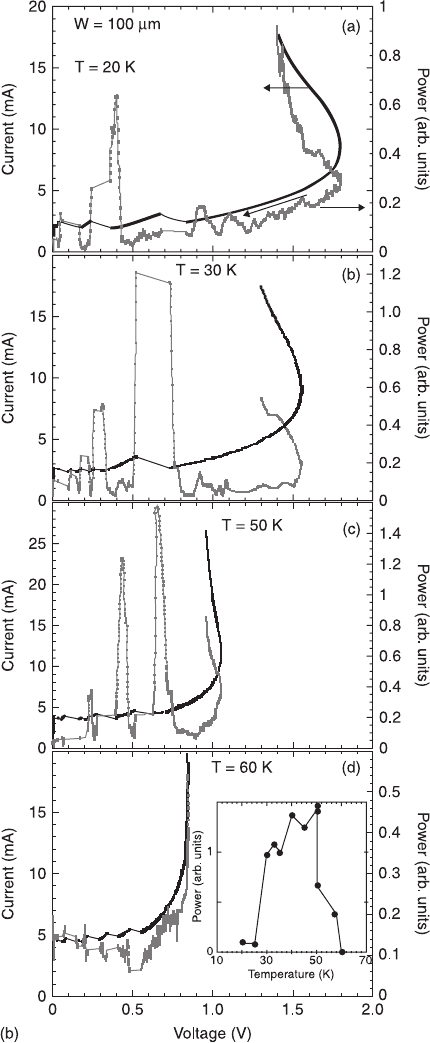
354 High-temperature superconductors
1
2
3
4
5
6
7
8
9
10
1
2
3
4
5
6
7
8
9
20
1
2
3
4
5
6
7
8
9
30
1
2
3
4
5
6
7
8
9
40
1
2
43X
© Woodhead Publishing Limited, 2011
8.30 Continued.
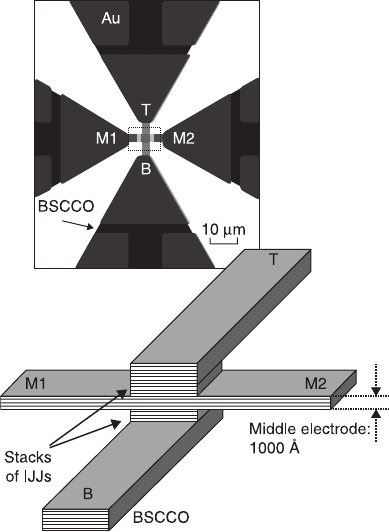
High-T
c
Josephson junctions 355
1
2
3
4
5
6
7
8
9
10
1
2
3
4
5
6
7
8
9
20
1
2
3
4
5
6
7
8
9
30
1
2
3
4
5
6
7
8
9
40
1
2
43X
© Woodhead Publishing Limited, 2011
They also observed higher harmonics up to the 4th order resulting in a frequency
exceeding 2.5 THz. The geometrical resonances lead to restrictions in the emitted
frequencies but Gray et al. (2009) have demonstrated that a proper shape of the
resonator like a trapezoidal mesa cross-section yields to THz-sources with
voltage-tunable emission frequencies. Computer simulations by Lin, Hu and
Tachiki (2008) show that cavity resonances of the transverse plasma occur in the
intrinsic Josephson junctions with frequencies up to 7 THz. The frequency as
well as the energy of emission can be tuned almost continuously by the current
and an external magnetic field. The emitted energy per area can go up to about
400 W/cm
2
.
An additionally nanoelectrode of a thickness of 100 nm in the middle of an
intrinsic Josephson junction array was realized by Wang et al. (2005) to investigate
the self-heating effect, Fig. 8.31. This electrode provides an easy access to the
8.31 Optical microscope image and scheme of a BSCCO intrinsic
Josephson junction (IJJ) with a 100-nm-thick middle electrode (Wang et
al., 2005, Fig. 1, Copyright (2005) by the American Institute of Physics).
Reprinted with permission from Wang HB, Hatano T, Yamashita T, Wu
PH, and Müller P (2005), ‘Direct observation of self-heating in intrinsic
Josephson junction array with a nanoelectrode in the middle’, Appl.
Phys. Lett. 86, 023504, Fig. 1, Copyright (2005) by the American Institute
of Physics.
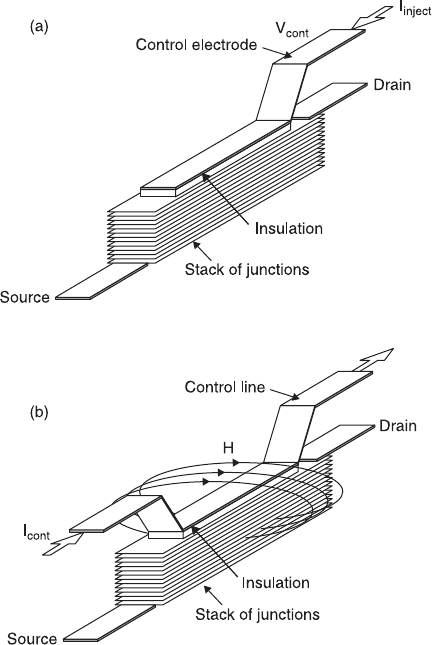
356 High-temperature superconductors
1
2
3
4
5
6
7
8
9
10
1
2
3
4
5
6
7
8
9
20
1
2
3
4
5
6
7
8
9
30
1
2
3
4
5
6
7
8
9
40
1
2
43X
© Woodhead Publishing Limited, 2011
inside of the intrinsic arrays for better understanding of their physics but it may
find application in superconducting digital circuits, three-terminal devices, 3-D
arrays, and other devices in superconducting electronics, too. Some possible
applications of intrinsic Josephson junctions for three-terminal devices have been
summarized by Yurgens (2000). Figure 8.32 shows some suggested three-terminal
devices like quasiparticle-injection or electric field-effect devices as well as a
vortex-flow transistor. The extreme dimensions of the intrinsic junctions will
increase the sensitivity and performance of such devices compared to artificially
stacked thin film structures.
8.32 Suggested three-terminal devices based on stacks of intrinsic
Josephson junctions: (a) quasiparticle-injection or field-effect
transistors, (b) vortex-flow transistor (Yurgens, 2000, Fig.17. Copyright
(2000) by IOP Publishing Ltd). Reprinted with permission from
Yurgens A (2000) ‘Intrinsic Josephson junctions: recent developments’,
Supercond. Sci. Technol. 13, R85–R100, Fig. 17. Copyright (2000) by IOP
Publishing Ltd.
High-T
c
Josephson junctions 357
1
2
3
4
5
6
7
8
9
10
1
2
3
4
5
6
7
8
9
20
1
2
3
4
5
6
7
8
9
30
1
2
3
4
5
6
7
8
9
40
1
2
43X
© Woodhead Publishing Limited, 2011
Another field of possible application for intrinsic junctions will be their use in
qubits. The large superconducting gap suggests the potential advantage that they can
operate at higher temperatures or for longer decoherence times. In particular, the
phase qubits based on the current-biased junctions are promising since the
experimental observation of the macroscopic quantum tunnelling (MQT) in intrinsic
Josephson junctions (Inomata et al., 2005, 2007; Maeda et al., 2006; Jin et al., 2006;
Kashiwaya et al., 2008). But the details of these experiments show the importance
of multi-junction effects, d-wave symmetry, self-heating and current fluctuations.
These problems have to be solved for application in quantum computing.
The nonlinear inductance of misaligned Tl-2212 thin film microbridge arrays
on 20° vicinal LaAlO
3
substrates was applied to tunable filters with a good
selectivity (Zhou et al., 2007).
8.6 Hybrid junctions
8.6.1 Physics of hybrid junctions
In the beginning, the combination of a conventional superconducting electrode of
s-wave order parameter symmetry with a high-T
c
electrode was done to study the
paring symmetry of the high-T
c
superconductors. The properties of the hybrid
Josephson junctions depend on the crystal orientation of the high-T
c
material because
the sign of the phase of the order parameter is different in the a- and b-direction
within the CuO
2
-planes because of d-wave symmetry. So-called corner junctions
were introduced to test this behaviour, Wollman et al. (1993). Later, the geometry
was fixed to obtain π-junctions where the phase shift of 180 degrees results in zero
critical current for zero magnetic field, Kirtley et al. (1997). An excellent overview
on π-junctions and their physics is given by Hilgenkamp (2008). It should be
mentioned that π-junctions can also be obtained by the intrinsic phase shifts inside
superconductor–ferromagnet–superconductor (SFS) junctions. Their operation is
based on the spatial oscillations of the phase of the wave function in the ferromagnet
induced by the proximity effect. Because up to now high-T
c
superconductors have
just started to be used for SFS junctions, see e.g. Volkov and Efetov (2009) and
references therein, we will concentrate on the hybrid junctions here. The ramp-edge
hybrid junction in the YBCO-Au-Nb technology is currently the most advanced
technique to create π-shift structures. Chesca et al. (2008) have shown that these
junctions have a purely sinusoidal current-phase relation which is essential to take
into consideration for their implementation as qubits or π-junctions in digital circuits.
Well-defined zigzag-shaped ramp-type hybrid junctions within this technology have
been investigated by Smilde et al. (2002a). These arrays present controllable model
systems to study the influences of π-facets in high-angle high-T
c
grain boundaries,
see section 8.3. The magnetic field dependencies of the critical currents provide
evidence for the d-wave-induced alternations in the direction of the Josephson current
between neighbouring sides of the zigzag structure, Fig. 8.33.
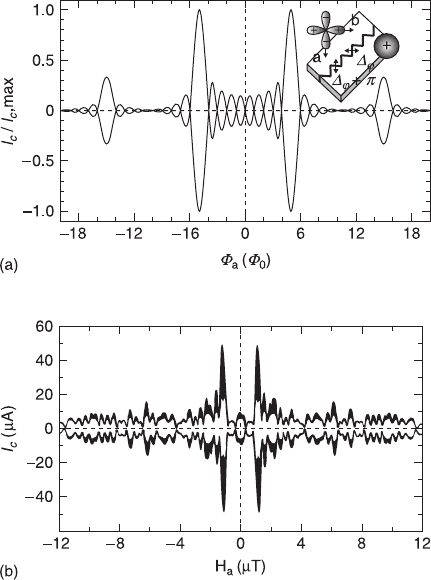
358 High-temperature superconductors
1
2
3
4
5
6
7
8
9
10
1
2
3
4
5
6
7
8
9
20
1
2
3
4
5
6
7
8
9
30
1
2
3
4
5
6
7
8
9
40
1
2
43X
© Woodhead Publishing Limited, 2011
8.6.2 Preparation and performance of hybrid junctions
The coupling of the s-wave niobium to the d-wave YBCO is realized via a very
thin Au layer in a ramp-edge geometry (Fig. 8.15) because the etched YBCO step
surface has to be covered in situ. In any case, the oxygen outdiffusion leads to a
thick barrier region without Josephson tunnelling. It was discussed if (and how)
this very thin normal layer has an influence on the junction behaviour. It is
assumed that the proximity effect of the niobium–gold interface leads to a
conventional superconducting order parameter at the interface to the d-wave
8.33 YBCO-Nb zigzag junction: (a) scheme and calculated magnetic
flux dependence of critical current for an array of ten facets composed
of standard and
π
-junctions, (b) experimental result for such an array
(Smilde et al., 2002a, Figs 1 and 3a, Copyright (2002) by the American
Physical Society). Reprinted with permission from Smilde HJH,
Ariando, Blank DHA, Gerritsma GJ, Hilgenkamp H, and Rogalla H
(2002a), ‘d-wave-induced Josephson current counterflow in YBa
2
Cu
3
O
7
Nb zigzag junctions’, Phys. Rev. Lett. 88, 057004, Figs 1 and 3a,
Copyright (2002) by the American Physical Society.
High-T
c
Josephson junctions 359
1
2
3
4
5
6
7
8
9
10
1
2
3
4
5
6
7
8
9
20
1
2
3
4
5
6
7
8
9
30
1
2
3
4
5
6
7
8
9
40
1
2
43X
© Woodhead Publishing Limited, 2011
YBCO. The reduction of the bulk niobium order parameter amplitude leads to a
reduction of the I
c
R
N
-product but at 4.2 K it is still about 1 mV.
The YBCO-Au-Nb technology leads to small spreads and high time stability of
the devices with up to 100 Josephson junctions which allows application in simple
SFQ circuits.
8.6.3 Selected applications of hybrid junctions
Beside application in basic research connected to order parameter symmetry and
unusual Josephson coupling, the main interest in hybrid junctions results from the
possibility of realizing standard as well as π-junctions within one well-established
technology.
Superconducting loops with π-junctions produce a circulating current depending
on the magnetic flux through the loop. Spontaneously generated half-flux quanta
are the basis for building a bistable system in which the polarity of the flux is
controllable by a current pulse. This can be used for different RSFQ circuits like
a toggle-flip-flop (TFF) demonstrated by Ortlepp et al. (2007). In this TFF it was
realized the internal states, represented by the polarity of half-flux quantum in
π-rings, can be controllably toggled by applying single flux quantum pulses.
Because of the natural bistability of the π-rings the symmetry of the logic devices
is improved. In this way operation margins are enhanced to a level that there is
no need of additional bias current lines compared to standard RSFQ circuits,
Fig. 8.34. This also leads to a miniaturization of the circuits.
Kawabata et al. (2007) have demonstrated MQT for hybrid junctions and
pointed out that due to a quasiparticle-tunnelling blockade effect the decoherence
time of s/d qubits is expected to be much longer than that of the d/d qubits. This
result suggests the high potential of hybrid junctions for applications in quantum
information devices.
Finally, an unusual application of hybrid junctions should be mentioned.
Kimura et al. (2008) reported on a Scanning Josephson Tunnelling Microscope
(SC-STM) which uses a conventional superconducting tip (Pb with an Ag capping
layer) instead of the normal conducting standard. By scanning high-T
c
superconducting single crystal (Bi
2
Sr
2
CaCu
2
O
8 +
δ
) the Josephson current across
the surface is measured and yields local values of the I
c
R
N
product at 2.1 K.
Corresponding energy gap measurements were also performed and a surprising
inverse correlation was observed between the local I
c
R
N
product and the local
energy gap. This result is unexpected from BCS theory but consistent with the
phase fluctuation model (Emery and Kivelson, 1995).
8.7 Future trends
Within the last few years there has been impressive progress in the quality of
high-T
c
superconducting films, multilayers with other materials, and reduction of
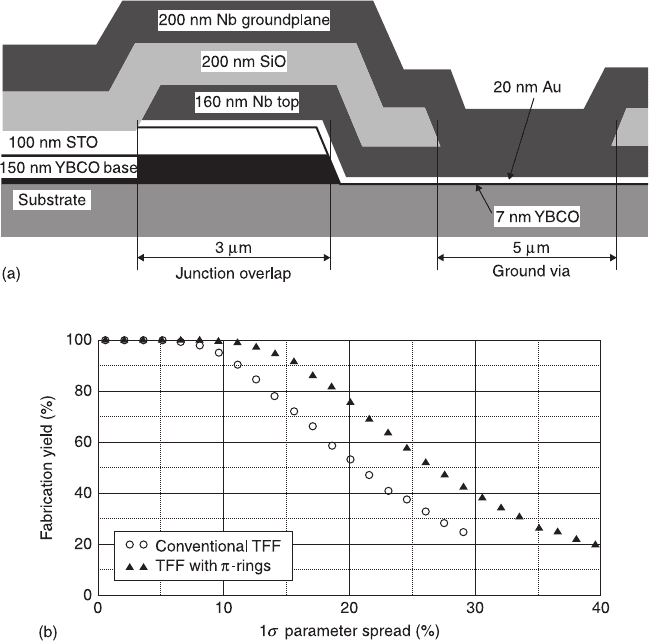
360 High-temperature superconductors
1
2
3
4
5
6
7
8
9
10
1
2
3
4
5
6
7
8
9
20
1
2
3
4
5
6
7
8
9
30
1
2
3
4
5
6
7
8
9
40
1
2
43X
© Woodhead Publishing Limited, 2011
parameter spread of Josephson junctions on a chip as well as from chip to chip.
The deeper understanding of the nature of the high-T
c
materials, especially their
complex order parameter symmetry, the spontaneously induced currents connected
to a full or a half-flux quantum state and the high asymmetry in all properties, lead
to new kinds of Josephson effects like intrinsic junctions or π-junctions,
respectively. Even if there is still no general microscopic theory for the high-T
c
superconductors these materials offer a lot of new applications in superconductive
electronics and sensor systems. The first prototypes of high-T
c
Josephson junction
8.34 (a) Cross-section of a hybrid ramp-edge junction in YBCO/Au/
Nb technology including a niobium groundplane, (b) fabrication yield
on parameter spread for a toggle-flip-flop by conventional junctions
compared to hybrid junctions in π-rings (Ortlepp et al., 2007, Figs 6
and 8, Copyright (2007) by IEEE). Reprinted with permission from
Ortlepp T, Ariando, Mielke O, Verwijs CJM, Foo KFK, et al. (2007),
‘RSFQ circuitry using intrinsic
π
-phase shifts’, IEEE Trans Appl.
Supercond. 17, 659–663, Figs 6 and 8, Copyright (2007) by IEEE.
High-T
c
Josephson junctions 361
1
2
3
4
5
6
7
8
9
10
1
2
3
4
5
6
7
8
9
20
1
2
3
4
5
6
7
8
9
30
1
2
3
4
5
6
7
8
9
40
1
2
43X
© Woodhead Publishing Limited, 2011
applications have been demonstrated using specialized single junctions or arrays
with up to 100 junctions. The ‘SCENET roadmap for superconductor digital
electronics’ by ter Brake et al. (2006) gives an overview in status and future
developments and summarizes that after the ‘decade of the materials science’ it is
now the turn of the ‘decade of the market’.
High-T
c
Josephson junctions promise about a ten times higher circuit speed than
low-T
c
ones corresponding to their ten times larger I
c
R
N
product. The additional
advantage of ‘self-shunted’ junctions requires no external normal conducting shunt
resistors which leads to smaller areas for circuits on chips. The main problem up to
now has been the quite large spread in junction parameters which limits the circuit
complexity to 10–100 Josephson junctions. In spite of these drawbacks ter Brake
et al. (2006) expected to have important niche applications in hand-held equipment
and satellite payloads, where low weight, size and cooling power consumption (as
compared to those for low-T
c
Josephson circuits) is a decisive issue.
Trends in HTS JJ technology are connected to miniaturization like sub-
micrometer junctions and use of intrinsic JJ arrays. Here the problem of spread is
still unsolved but progress like the ‘double-sided technology’ is going on. Thus
progress in voltage standards and voltage synthesizers as well as in radiation
sources and THz applications have to be expected in the near future. For single
junctions and spatial distributed arrays application as mixers, radiation detectors
and sources up to THz range will be realized not only for astronomy but for X-ray
spectroscopy and THz imaging, too.
Finally, it should be mentioned that there is rising interest in high-T
c
Josephson
junctions for solid-state qubits because of the new possibilities to manipulate
quantum phases and their higher intrinsic stability.
Many new aspects have to be expected by other materials used for the junctions,
for example for coupling barriers or metal electrodes. Even for the high-T
c
superconductors there may be new materials besides MgB
2
used in the future. The
discovery of the iron-pnictides (Kamihara et al., 2008; Chen et al., 2008) gives
the possibility of replacing the standard cuprates. Up to now there have mainly
been basic works to study the symmetry of the order parameter in these materials
(e.g. Parish et al., 2008; Hicks et al., 2009) and deriving novel properties in
Josephson junctions involving the pairing state of the iron-pnictides (Tsai et al.,
2009; Parker and Mazin, 2009), but first hybrid Josephson junctions with FeAs
single crystals and Pb counter-electrodes have been demonstrated (Zhang et al.,
2009a). All-pnictide Josephson junctions were realized by crossing two differently
doped single crystals (Zhang et al., 2009b) or with thin films on bicrystal substrates
resulting in grain boundary junctions (Katase et al., 2010). The reported rather
conventional behaviour of the pnictide Josephson junctions looks very promising
as RSJ-like IV-characteristics with quite small I
c
R
N
products, clear Shapiro steps,
and Fraunhofer-like magnetic field dependence of the critical Josephson current
were reported. There may be some new kinds of Josephson junctions based on the
assumed extended s-wave symmetry of some of the Fe-based superconductors.
